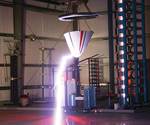After lightning strikes: Repair considerations
When lightning does strike, aircraft LSP system repairs must be done correctly to ensure restoration of protection.
“Lightning strike is a huge problem for any aircraft,” says Paul Knudsen, a composites repair instructor with FlightSafety International West Palm Beach Learning Center (West Palm Beach, Fla.). His focus is on training composites technicians and designers to recognize the paths that lightning can take through a structure in a variety of fixed-wing aircraft and helicopters, and then determine how to make repairs that ensure lightning strike protection (LSP) restoration.
“Inspection is key — you have to look for the entrance and exit points and for pinholes,” he notes, adding that looks can be deceiving: “Sometimes, the outer surface burns look like pepper sprinkled over the paint.” Because every aircraft model employs a different LSP system, inspection and repair is model-specific.
Where damage to the LSP mesh or interwoven wire fabrics and underlying laminate has occurred, the area(s) must be sanded and scarfed down to undamaged plies. After the repair is complete and cured, Knudsen says, the focus is on the LSP repair, which is actually “two separate repairs.” Knudsen typically replaces the burned mesh or expanded foil using an epoxy adhesive like that supplied by Magnolia Advanced Materials Inc. (Chamblee, Ga.) so that the mesh is encapsulated by the resin, to prevent surface porosity and moisture ingress. He stresses that checking the conductivity of the LSP system with a milliohm meter is crucial. In addition, metallic strips or grounding straps should be inspected to ensure conductivity across the plane’s outer surface. After conductivity has been restored, the repaired surface can be repainted.
Related Content
-
The next-generation single-aisle: Implications for the composites industry
While the world continues to wait for new single-aisle program announcements from Airbus and Boeing, it’s clear composites will play a role in their fabrication. But in what ways, and what capacity?
-
Plant tour: Airbus, Illescas, Spain
Airbus’ Illescas facility, featuring highly automated composites processes for the A350 lower wing cover and one-piece Section 19 fuselage barrels, works toward production ramp-ups and next-generation aircraft.
-
“Structured air” TPS safeguards composite structures
Powered by an 85% air/15% pure polyimide aerogel, Blueshift’s novel material system protects structures during transient thermal events from -200°C to beyond 2400°C for rockets, battery boxes and more.



